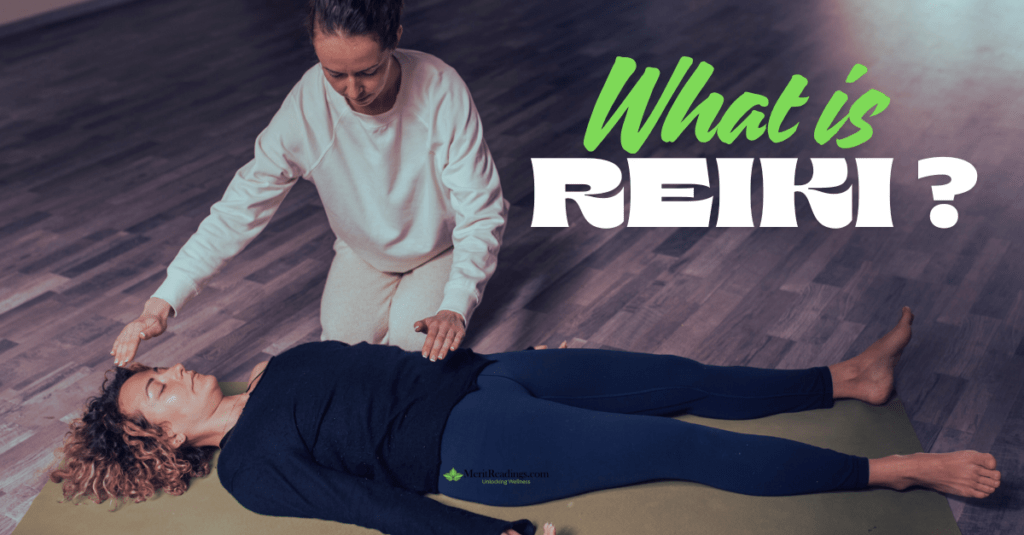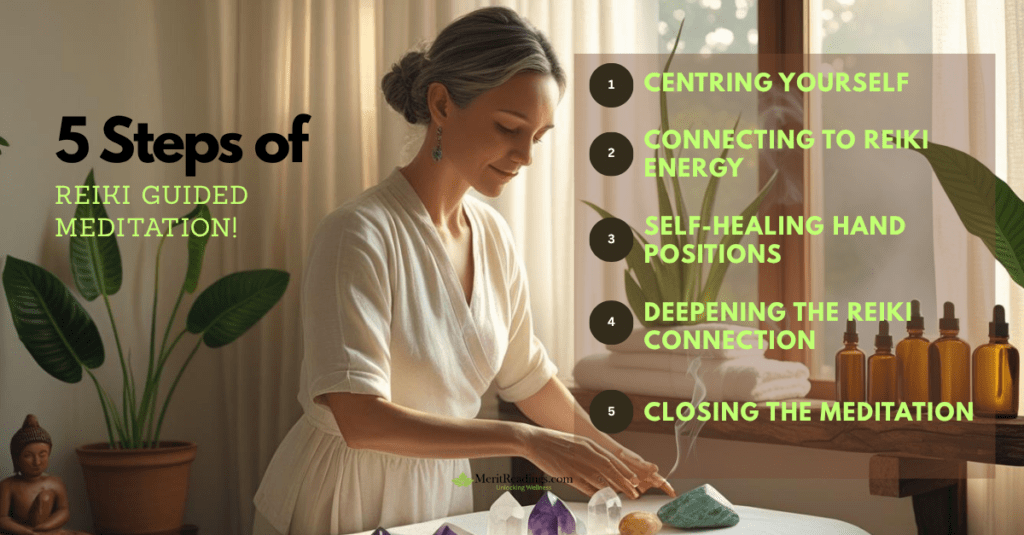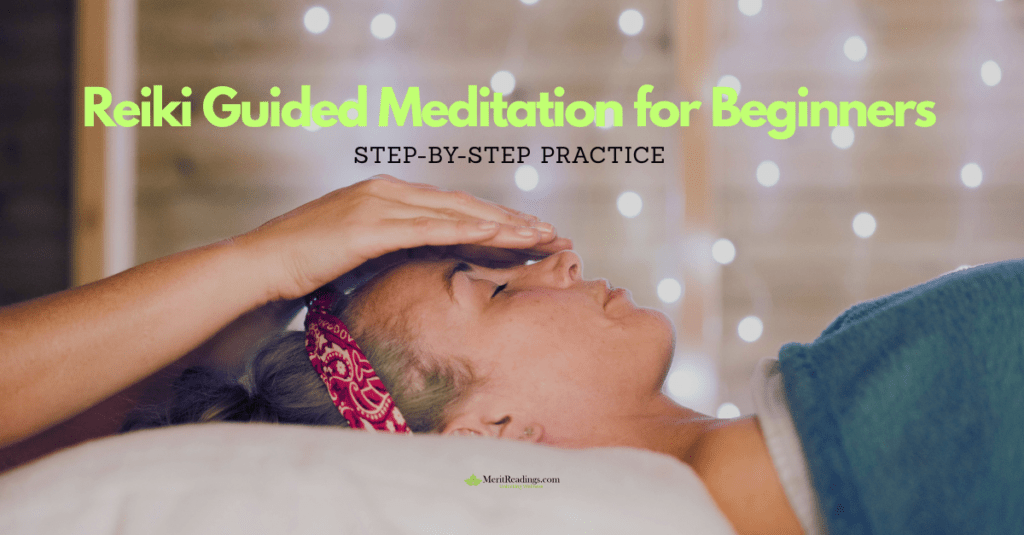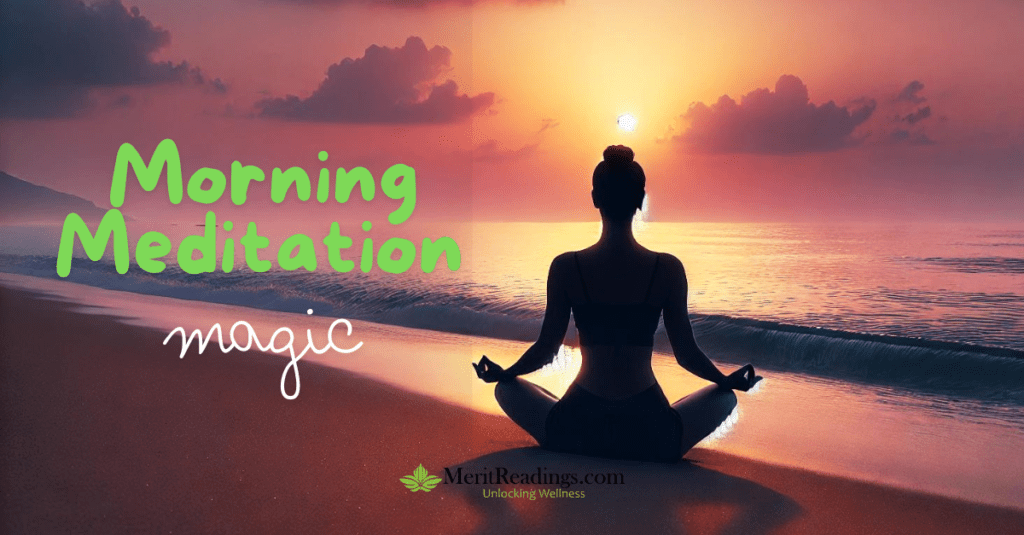Introduction
Reiki is a gentle and effective practice that uses the energy around us to promote relaxation, reduce stress, and help heal the body and mind. It’s a calming way to help balance your energy and emotions. You don’t need any special skills to start practicing Reiki. Guided Reiki meditation is a great way for beginners to connect with this healing energy. It will help you feel more relaxed and peaceful.
What is Reiki?

Reiki (pronounced “ray-key”) is a Japanese healing technique that helps balance the energy in our body. It was created by Mikao Usui in the early 20th century. The word “Reiki” means “universal life energy,” which is the energy that flows through all living things. This energy helps to heal and balance the body, mind, and spirit.
When this energy flows well inside you, it can help you feel better, both physically and emotionally. Reiki is a combination of Japanese energy healing techniques and knowledge of chakras (the energy centers in your body). Through Reiki, you can help restore balance, promote healing, and feel more peaceful.
Reiki is a safe practice that can be used by anyone, whether you’re helping yourself or others. It doesn’t involve any physical touch; instead, it works by using energy to bring calm and healing to the person receiving it.
Benefits of Reiki Meditation

Reduces stress and anxiety
Promotes deep relaxation
Enhances emotional well-being
Improves focus and mental clarity
Supports physical healing and energy flow
Preparation for Reiki Meditation

1. Set Your Intention:
Take a moment to reflect on why you are practicing this meditation. Your intention could be to reduce stress, heal emotionally, or simply connect with your inner self.
Example intentions:
“I intend to release tension and invite peace into my life.”
“I intend to heal and balance my energy.”
Write your intention down if it helps you focus.
2. Choose Where to Do Reiki:
Select a quiet, comfortable space where you won’t be disturbed. This could be a cozy corner in your home, a dedicated meditation room, or even a peaceful outdoor setting like a garden or park.
Ensure the space feels safe and inviting. If possible, choose a spot where you can return regularly to build a sense of ritual and familiarity.
3. Create Physical Comfort:
Chair vs. Lying Down:
If sitting, choose a chair with good back support. Sit with your feet flat on the floor and your hands resting comfortably on your lap or thighs.
If lying down, lie flat on your back with your arms by your sides, palms facing up. Place a small pillow under your knees to support your lower back and reduce strain.
4. Clothing:
Wear loose, comfortable clothing that doesn’t restrict your breathing or movement. Avoid tight belts, collars, or waistbands. If needed, loosen or remove anything that feels constricting.
5. Temperature:
Ensure the room is at a comfortable temperature—neither too hot nor too cold. If needed, use a light blanket to stay warm or adjust the thermostat to avoid shivering or sweating.
6. Set the Mood:
Dim the Lights:
If practicing in the evening, turn down bright lights or use a small lamp. You can also use candles to create a warm, soothing atmosphere. The soft glow will help you relax and focus.
7. Play Soft Music (Optional):
Gentle Reiki music, meditation tunes, or nature sounds (like ocean waves, flowing water, or birds chirping) can enhance relaxation. Avoid music with lyrics, as it can be distracting.
8. Use Essential Oils (Optional):
Aromatherapy can deepen your relaxation. Use a diffuser or apply a drop of essential oil to your wrists or temples. Great choices for meditation include:
Lavender: Promotes calmness and relaxation.
Sandalwood: Enhances focus and spiritual connection.
Frankincense: Encourages grounding and inner peace.
9. Prepare Your Body:
Sit in a comfortable position with your spine straight. You can sit on a chair, cushion, or the floor. If sitting is uncomfortable, lie down on your back with your arms by your sides, palms facing up.
Use a blanket or pillow for extra comfort if needed.
10. Ground Yourself:
Close your eyes and take a few deep breaths. Inhale deeply through your nose, allowing your abdomen to expand. Hold the breath for a moment, then exhale slowly through your mouth.
As you breathe, imagine roots growing from the base of your spine (or the soles of your feet if lying down) and anchoring you to the earth. This helps you feel stable and connected.
Step-by-Step Reiki Guided Meditation

Step 1
Centring Yourself (Deep Breathing & Relaxation)
Before connecting to Reiki energy, it’s important to calm the mind and enter a relaxed state.
1. Begin with Deep Breathing
Focus on your breath as you inhale deeply and exhale slowly.
Let go of any tension with each breath.
Time: Continue for 1-2 minutes to fully settle into your breath.
2. Focus on Relaxation
Feel your body relax with each exhale.
Let go of any thoughts and allow your body to settle into a state of calm.
Time: Practice for another 1-2 minutes to deepen your relaxation.
3. Breathing and Relaxation Techniques
- Diaphragmatic Breathing (Belly Breathing)
Place one hand on your chest and the other on your belly.
Inhale deeply through your nose, allowing your belly to rise while keeping your chest still.
Exhale slowly through your mouth, feeling your belly fall.
Time: Repeat this for 5 breaths, focusing on expanding the diaphragm.
- Counting Breaths (Rhythmic Breathing)
Inhale for a count of four (1…2…3…4).
Hold the breath for a count of four (1…2…3…4).
Exhale for a count of six (1…2…3…4…5…6).
Time: Repeat this cycle 5-10 times until you feel calm.
- Progressive Relaxation: Unwinding Tension
Feet: Wiggle your toes, then tighten and release the muscles in your soles, arches, and ankles.
Legs: Tense your calves and thighs, then let them relax completely.
Hands & Arms: Clench your fists, hold, then release. Roll your shoulders gently.
Face & Jaw: Scrunch your face, then let your forehead, jaw, and cheeks go soft.
Whole Body: Take a deep breath in, tighten your whole body briefly, then exhale and let go.
Time: Spend 5-10 minutes focusing on relaxation and tension release.
- Breath Awareness (Mindful Breathing)
Focus on the sensation of air entering and leaving your nostrils.
If your mind starts to wander, gently bring your attention back to your breath.
Allow any thoughts to drift away like clouds in the sky.
Time: Spend at least 1-2 minutes focusing on your breath and clearing your mind.
Step 2
Connecting to Reiki Energy
This step helps you invite Reiki healing energy into your body.
1. Hand Position
Place your hands in the Gassho position, which involves bringing your palms together at your heart center, with your fingers gently touching.
This is a gesture of gratitude and connection, helping to ground your energy and open yourself to the Reiki flow.
2. Set Your Intention
Silently say to yourself:
“I welcome Reiki energy for healing and relaxation.”
“I am open to receiving positive energy.”
“May this session bring peace and balance.”
3. Visualize Reiki Energy Flowing In
Imagine a bright, golden light above your head. This light represents the universal life force energy (Reiki).
Visualize this light gently flowing down through the crown of your head, like a waterfall of warmth and healing.
Feel it filling your entire body, from the top of your head to the tips of your toes.
4. Scan Your Body with Reiki Energy
Slowly bring your awareness to each part of your body, starting from the top of your head and moving downward. As you focus on each area, imagine the Reiki energy healing and relaxing that part of your body.
Example: Body Scan with Reiki Energy
Head: Feel the light dissolving any tension in your scalp, forehead, and jaw.
Neck and Shoulders: Imagine the light melting away stress and tightness.
Arms and Hands: Feel the energy flowing through your fingers, releasing any stored tension.
Chest and Heart: Visualize the light filling your heart with love and compassion.
Abdomen: Feel the light soothing your digestive system and calming your emotions.
Legs and Feet: Imagine the light grounding you and connecting you to the earth.
5. Feel the Reiki Energy
Sit with this feeling of warmth and relaxation for a few moments.
If thoughts arise, gently bring your focus back to the glowing light within you.
Step 3
Self-Healing Hand Positions
Reiki healing uses hand placements to direct energy. Hold each position for 3-5 minutes (or longer if needed).
1. Crown Chakra (Top of the Head)
Place both hands gently on the top of your head.
Imagine white light filling your mind, bringing clarity and peace.
2. Third Eye Chakra (Forehead)
Move your hands to your forehead, with fingertips touching.
Picture a deep blue light glowing at the center of your forehead, enhancing intuition.
3. Throat Chakra (Neck/Throat)
Gently place hands on your throat.
Imagine a soft blue light expanding from your throat, helping you express your truth.
4. Heart Chakra (Center of Chest)
Place hands over your heart, palms flat.
Picture a green light expanding from your heart, filling you with warmth and love.
5. Solar Plexus Chakra (Upper Stomach)
Move hands to the area just above your navel.
Imagine a bright yellow light radiating from your stomach, filling you with confidence.
6. Sacral Chakra (Lower Abdomen)
Place hands just below your belly button.
Visualize an orange light swirling in your lower belly, bringing joy and creativity.
7. Root Chakra (Base of Spine or Feet)
Place hands on your lower back, hips, or feet.
Imagine a red light at the base of your spine, anchoring you to the Earth.
Step 4
Deepening the Reiki Connection
Now that energy is flowing, sit still and focus on the warmth in your body.
If negative thoughts arise, imagine them dissolving into light.
Silently repeat a mantra, such as:
“I am calm, I am healing.”
“Reiki energy flows freely through me.”
“I release what no longer serves me.”
Stay in this state for at least 5-10 minutes (or longer if you wish).
Step 5
Closing the Meditation
1. Express Gratitude
Bring your hands back to Gassho position.
Silently thank Reiki energy for the healing session.
2. Take Deep Breaths
Inhale deeply and feel grounded in your body.
Slowly exhale and feel fully present.
3. Open Your Eyes Gently
Blink a few times to adjust to the surroundings.
Move your fingers and toes to reconnect with your body.
Ending the Meditation: Returning Refreshed
1. Gentle Re-entry
Avoid abrupt movements. Take your time to transition back to your waking state.
Rotate your wrists and ankles slowly.
Stretch gently, letting your body ease back into the present moment.
2. Mindful Observation
Before opening your eyes, take a moment to notice your thoughts and feelings without judgment.
Observe any changes in your energy level or mood.
Whether you feel lighter, more relaxed, or neutral, it’s all part of the process.
3. Journaling and Integration
If you like journaling, write down any insights, sensations, or emotions that came up during the session.
Throughout the day, try to carry the sense of peace and calm that you’ve cultivated during the meditation.
If you didn’t feel anything specific, that’s perfectly fine and normal. Trust that the healing energy is working in its own way.
After Meditation: Grounding Yourself
1. Drink Water
Drink a glass of water to help energy flow and maintain hydration.
2. Stretch or Walk
Stretch your body or take a short walk to reconnect with the physical world.
3. Journal Your Experience
If you haven’t already, write down any insights, emotions, or changes you experienced during meditation. This can help you process the experience.
Tips for Beginners
1. Start Small
Begin with 5–10 minutes and gradually increase the duration as you become more comfortable.
2. Be Consistent
Practice regularly, even if it’s just a few minutes a day, to build a habit.
3. Be Patient
It’s normal to feel distracted or unsure at first. With time, your focus and connection to Reiki energy will grow.
4. Listen to Your Body
If you feel uncomfortable at any point, adjust your position or stop the meditation.
Conclusion
This guide combines relaxation techniques, Reiki body scanning, and energy flow visualization to help you connect with Reiki in an easy and clear way. Each step is meant to help you relax your body and focus your mind, making the Reiki meditation more effective.
Reiki is all about trusting the process. You may not feel strong sensations right away, but the energy is still working. With time and practice, you will feel more balanced, calm, and peaceful.
Be patient with yourself, practice regularly, and you will notice the positive changes Reiki brings to your life.



